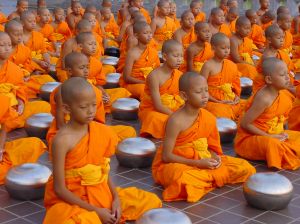I woke from sleep in the early morning hours recently, and my first conscious thought consisted of the word “provisionality”. It was as prominent as if a banner with the word had been hoisted across the foot of my bed. And I knew at once why it was there, and what it meant.
A few hours earlier I’d been struggling unsuccessfully to draft an article on meditation for this blog. This unannounced and unexpected banner-headline in the quiet of my bedroom, in the dark, turned a searchlight on my struggle, and resolved it.
While I was sitting in front of my monitor, I couldn’t put into words the conflict I was experiencing about Robert’s intelligent disquisition on the hindrances to meditation, which seemed to reflect the kind of stuff I’ve read before in Buddhist tracts and articles about how arduous and difficult meditation is, but worthwhile for the ultimate reward of solitary ecstasy . They all have that hallmark of the experience of robed sitting by people, almost exclusively men, who – by sitting in meditation for many years and by assiduous effort, overcoming formidable obstacles and hindrances – have reached the pinnacle of spiritual attainment, personal enlightenment.
How could I question that? Yet I still do, insistently.
Let me return to my sudden waking up, and set aside the conflict for a moment, though I think they’re linked somehow. Maybe that’s my inner philosopher in me speaking, with new-found confidence, and in a softer, more open and provisional style.
What follows is a rather crude and simplistic comparison of two approaches to meditation, devised by me, and based on my own experience of, observation of, and talking with women, especially nurses, but also Buddhist women, and of women in Africa, where lifestyle is still quite other than here in the developed Northern hemisphere (still curiously referred to as ‘the West’).
‘Male ‘model of meditation and principles of practice
Emphasises physical stillness in a prescribed erect sitting posture, eyes closed to shut out worldly distractions.
More or less totally (and deliberately) divorced from all forms of common worldly activity or engagement with other people e.g. social or family relationships, childcare, sexuality, work (including housework and gardening or growing crops), play, leisure, celebration, contingent events etc.
Performed in complete silence, often regards sound as a distraction or as contamination.
Solitary practice encouraged, group meditation takes care to exclude the possibility of any physical contact by meditators.
Oriented to personal achievement of bliss, ascending hierarchy of attainment (simile: climbing a lofty mountain, leaving the world and its cares far below).
Highly structured, elaborately detailed, concept-laden and often ‘scripted’ technique to be followed, rigour recommended.
Narrow focus of attention, discipline and effort prized.
Body regarded as vehicle for mind, used instrumentally, often seen as source of undesirable distraction from mind (Body-Mind dualism).
Teaching (on technique and to provide ideological buttressing) originated, articulated, controlled and directed (almost exclusively) by men.
Women’s voices and unique experience marginalised.
‘Female’ model of meditation and principles of practice
Allows and promotes activity and movement, spontaneous and purposive, open to the world and embraces it, eyes open.
Integrates short, naturally occuring periods of stillness, silence and relaxed, comfortable repose (no imposed postural requirements) with activities of daily living, and seamlessly in relationship with other people (specially attentive to children, the elderly, or animals), on an emergent basis as life unfolds.
Encourages and welcomes togetherness, especially the company of other women.
Characterised by shared conversation, or singing/crooning, and comfortable shared silence, especially when carrying out shared activities (household tasks, cultivating gardens, fetching water or firewood, weaving or sewing, pounding or sieving grains, community cooking,
reciprocal grooming like hair plaiting, manicure etc).
Oriented to cooperative, cohesive and collective purposes.
Uncontrivedly self-effacing and ‘unselfish’.
Body-mind understood in ‘wholistic’ terms, expressed as an intuitive apprehending of feelings, and understanding sensations as metaphors of influence and meaning, a naturalistic and concept-free ‘integration of desires’.
Wide focus of attention, open to the whole visual (and aural and osmic) field, while (like a bird) able to pick up particular detail. (‘without stirring from the unity of self-refreshing pristine awareness, the details of experience are clearly differentiated without being contrived’ [Longchenpa])*
Uncontrived: elaborate conceptual expressions of technique and ideological underpinnings for meditation experienced as redundant, at variance with women’s experience, and ironically referred to as “typically male” or in other earthy, bawdy terms…..!)
Teachings shared informally, in light jests or personal anecdotes, by story-telling, in songs or poems, in pictures, or by clothing, body adornments, experiment and innovation in make-up and hair-styling,
through the positioning and re-arrangement of household articles, artefacts, flowers or elemental things (feng shui).
Women will share generously and with no expectation of reward or desire for acclaim or special ‘recognition’.
Men only have to notice that they are there, and that their contribution to meditation practice, although divergent, is of equal value to mens’.
* Quoted from Longchenpa, You Are the Eyes of the World, translated by Lipman K, Peterson M (2000), Snow Lion Publications, New York










Hi Peter,
I’d agree that there are more and less structured, and more and less social, forms of integrative practice. However, I’m not sure that it is helpful to identify these with gender. I appreciate that you are trying to do this loosely and provisionally, but even done like that I’m not sure about its value. For comparison, there is a preponderance of women on the political left and men on the right, but we don’t label Labour ‘Women’s party’ and Conservative ‘Men’s party’. The majority of people who practice formal meditation are also women. The gendered aspect of this just seems to be a red herring.
Also, if you must label things in terms of typical association with a particular gender, ‘masculine’ and ‘feminine’ are a lot more accurate than ‘male’ and ‘female’. There are, after all, masculine women and feminine men.
I’m also not sure that it’s helpful to label conversation, reciprocal grooming, or singing as ‘meditation’. They can be integrative activities, but meditation labels a specific type of technique. I’d agree that there is a blurry boundary between formal meditation and a meditative way of doing other activities, but meditation is distinguished by the directness with which it focuses on mental states. I’d also agree that meditation is not the only possible integrative practice, and might not be the best one for everyone. But I don’t quite understand the practical purpose behind your wish to apply the term ‘meditation’ as widely and indiscriminately as this.
However, you do raise a wider question: whether we value women’s contributions to integrative practice as much as men’s. That does seem to be important one. I’d certainly be interested to hear more women’s voices on that.
Thanks for your necessarily robust and constructive comments, Robert. I think the first question(s) they raise for me are:
Does meditation necessarily produce integration?
Is integration possible without meditation?
I’ve heard of/read about people (EckhartTolle is a contemporary example) who claim to have become ‘enlightened’ without any deliberate effort and without meditating. By their own accounts these people are as fully integrated as it is humanly possible to be.
On the other hand, it seems probable that lots of people who’ve meditated steadfastly and conscientiously for decades report not much more ‘progress’ towards enlightenment than if they’d spent the time and effort knitting socks, breeding pigeons, or painting water-colour landscapes.
Is there a relationship between meditation and integration, and can it be quantified? If not, why not?
I think my own argument (not supported by much other than anecdotal evidence) is that integration occurs independently of meditation (as defined). I think we are perpetually in a kaleidoscopic series of ‘altered states’, each of which holds potential for integration, with the proviso that a quantum of attention helps to catalyse the process, and that quantum doesn’t have to be of a particular size. Nano attention may well do it.
The answers to your questions seem fairly obvious:
Does meditation necessarily produce integration? No. It depends on the effectiveness of the meditation.
Is integration possible without meditation? Yes. There is a range of integrative practices we can use. I’d also agree with you that attention can be focused in smaller or larger bursts, whatever we are doing.
There we’re in full agreement. Where we seem to disagree is on the degree of importance of gender to such questions.
Just another question, Robert. Did you intend in your comment above to convey the idea that, of those individuals who practice formal meditation, the majority is women? Or were you suggesting that, amongst meditators, the majority use formal meditation techniques, and some amongst that majority are also women? Or was it something else?
It seemed a bit ambiguous. If it were the former, it would be at variance with my own experience of Buddhists across several different traditions, where most meditators have been men.
I intended the former. I’ve just had a quick search to see if I can find some statistics, but couldn’t find anything on numbers of women vs. men meditating. So I can’t provide you with any evidence; but as women are on average greater users both of healthcare (including therapies) and of religious groups, I would be extremely surprised if there were not more women meditating than men both in the UK and elsewhere in developed countries. In my experience of Buddhism (in Triratna) there are more men in positions of overall leadership, but more women involved in total.
I think you’re right, Robert. Although I’ve had a lot of contact with individual Buddhists from a wide range of different traditions, I’ve had little extended experience of Buddhist sangha/communities, so I’m basing my assessment on unreliable data.
Having said that, my ‘pastoral’ (chaplaincy) and hospice experience with sick and dying Buddhists (most of whom have not been active members of Buddhist communities for some length of time, for reasons of age, incapacity or reduced means) suggests that few western Buddhists of either gender maintain a commitment to regular formal meditation for long on their own.
While acknowledging its value in settling the mind, and generating calm and a degree of equanimity, most admit that they haven’t kept it up since they stopped going to the vihara or zendo.